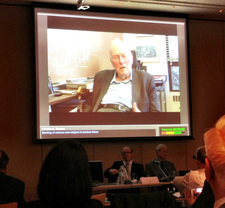New
In Memoriam: Charles Townes, inventor of laser, dies at 99.
Charles Hard Townes, a professor emeritus of physics at the University of California, Berkeley, who shared the 1964 Nobel Prize in Physics for invention of the laser and subsequently pioneered the entirely new industry, died on Jan. 27.
Townes was 35 in the spring of 1951 when he found the solution to a longstanding problem, how to create a pure beam of short-wavelength, high-frequency light. That revelation not much different from a religious revelation, Townes believed eventually led to the first laser, a now ubiquitous device common in science, telecommunication, entertainment and medicine, including phototherapy for vitiligo. Throughout his life, Townes maintained an interest in the intersection of science and religion.
VR Foundation had the privilege of inviting Charles Townes to the Roundtable On Vitiligo in Kitzbuhel, Austria in 2012, watch the video here . We wish his family our sincerest condolences at this time of loss, and we hold Professor Townes, one of the greatest scientists of the twentieth century, in fond and respectful memory.

FAQOther Questions
- What is the best therapy for localized vitiligo?
Localized vitiligo, where the white patches are limited to one or a few areas of the body, can be managed with a few treatment approaches. The best therapy usually depends on th...
- Is it possible to stop the progression of vitiligo?
While it's not always possible to quickly stop vitiligo progression, there are some treatments that can help slow or halt the spread of the condition in many cases: Corticoster...
- How to get insurance coverage for vitiligo treatments?
Getting insurance coverage for vitiligo treatments can be challenging, but there are several steps you can take to improve your chances For a more in-depth look, check out our ...
Though it is not always easy to treat vitiligo, there is much to be gained by clearly understanding the diagnosis, the future implications, treatment options and their outcomes.
Many people deal with vitiligo while remaining in the public eye, maintaining a positive outlook, and having a successful career.
Copyright (C) Bodolóczki JúliaBy taking a little time to fill in the anonymous questionnaire, you can help researchers better understand and fight vitiligo.
